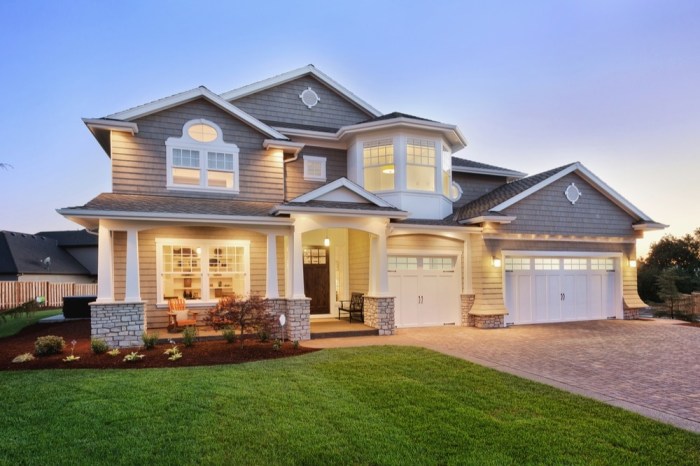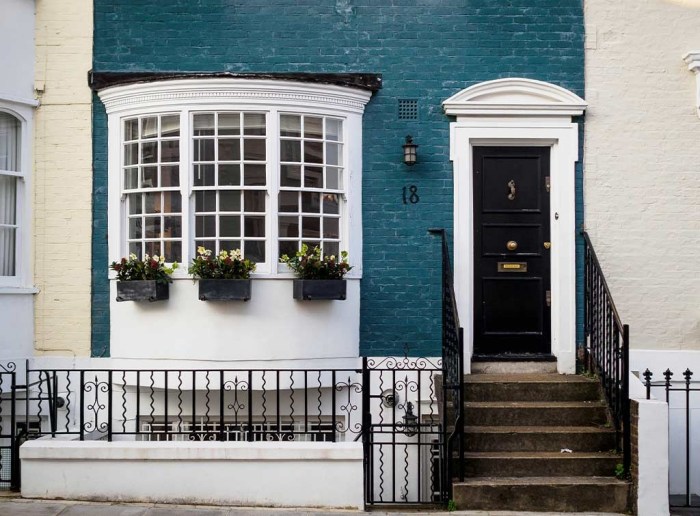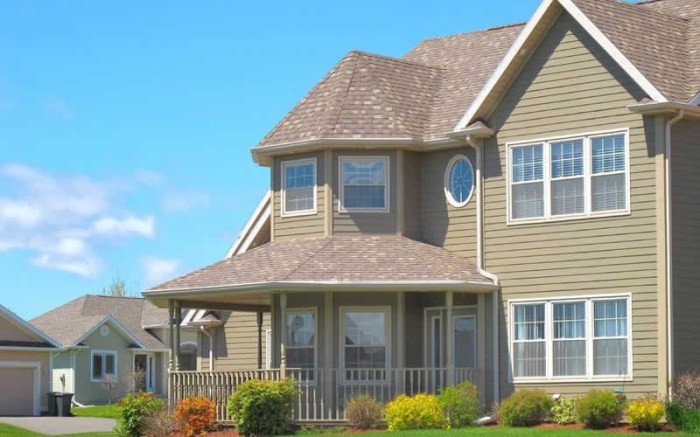Transforming your home’s exterior doesn’t require a king’s ransom. This exploration delves into practical, budget-friendly strategies to dramatically enhance your curb appeal. From the science of paint adhesion and the art of landscaping to the efficiency of updated fixtures and the satisfaction of DIY projects, we’ll uncover simple yet impactful methods to revitalize your home’s facade. Prepare to discover how strategic choices in paint type, landscaping design, and hardware selection can significantly elevate your property’s value and aesthetic appeal, all while keeping your wallet happy.
We’ll examine the chemical properties of various paint types, influencing durability and longevity. The physics of power washing will be considered, emphasizing safety and effective cleaning techniques. Landscaping principles, encompassing plant selection and growth patterns, will be discussed, alongside cost-effective materials for walkways and garden paths. Finally, we will explore the energy efficiency implications of updated lighting and hardware, backed by data on lifespan and cost comparisons.
Each step offers a blend of practical advice and scientific understanding to guide you toward a stunning and cost-effective exterior makeover.
Painting and Power Washing

Revitalizing your home’s exterior with a fresh coat of paint and a thorough cleaning can dramatically enhance its curb appeal and protect it from the elements. This process, while seemingly straightforward, requires careful preparation and execution to achieve lasting results. Understanding the science behind paint adhesion and surface preparation is key to a successful project.
Exterior Wall Preparation for Painting
Proper preparation is paramount for a long-lasting paint job. Neglecting this crucial step can lead to premature paint failure, requiring costly repairs down the line. The process begins with a thorough cleaning to remove dirt, mildew, loose paint, and other contaminants that could interfere with paint adhesion. This is often achieved through power washing (discussed later), followed by scraping away any loose or peeling paint using a scraper or putty knife.
After cleaning, any cracks, holes, or imperfections in the wall surface should be repaired using appropriate fillers and sealants. These repairs ensure a smooth, even surface for optimal paint application. Finally, the repaired areas should be sanded smooth and primed before painting. Primer acts as a bonding agent, improving paint adhesion and ensuring a uniform color.
Exterior Paint Types
Choosing the right exterior paint is crucial for both aesthetics and longevity. Different paint types offer varying levels of durability, cost-effectiveness, and ease of maintenance. The following table compares three common types:
| Paint Type | Cost | Durability | Maintenance |
|---|---|---|---|
| Acrylic Latex | Moderate | Good; resists fading and mildew | Low; easy to clean |
| Oil-Based | High | Excellent; very durable and long-lasting | Moderate; requires more specialized cleaning |
| 100% Acrylic | High | Excellent; superior resistance to fading, mildew, and cracking | Low; easy to clean |
Note that prices can vary based on brand and quality. For example, a premium 100% acrylic paint might cost more upfront but offer significantly longer lifespan, reducing long-term costs.
Power Washing a House: Procedure and Safety
Power washing effectively removes dirt, grime, and mildew from exterior surfaces. However, improper use can damage surfaces or cause injury. Before starting, always select the appropriate nozzle and pressure setting for the material being cleaned. For example, a lower pressure setting is needed for delicate surfaces like wood siding compared to concrete. Safety precautions are essential; wear protective eyewear, gloves, and closed-toe shoes.
Ensure adequate ventilation and maintain a safe distance from the surface being cleaned to prevent damage or injury from splashing water or debris.
Power Washing Checklist
Prior to beginning, create a checklist to organize your approach. This prevents accidental damage and ensures a thorough clean.
- Items to power wash: Siding, decks, patios, walkways, driveways (concrete or brick)
- Items to avoid power washing: Windows (unless using a low-pressure setting and specialized nozzle), delicate plants, freshly painted surfaces, and certain types of roofing materials (consult manufacturer recommendations).
Proper Paint Application Techniques
Achieving a professional paint finish involves more than just applying paint to the surface. Proper techniques ensure even coverage, prevent streaks, and maximize paint longevity. A visual guide would demonstrate the following:Imagine a visual guide showing:
1. Preparation
A masked window and a properly prepared surface free of debris and loose paint.
2. Cutting In
Precise application of paint along edges using a brush, creating a clean line.
3. Rolling
Using a roller with an appropriate nap length for the surface texture, applying paint in even, overlapping strokes, maintaining a wet edge.
4. Back-rolling
Lightly rolling over previously applied paint to ensure even distribution and prevent lap marks.
5. Final Inspection
A close-up of a smoothly painted surface, free of streaks, drips, or runs.The importance of using primer cannot be overstated. Primer creates a uniform surface for the paint to adhere to, resulting in a more durable and aesthetically pleasing finish. It also helps to seal porous surfaces, preventing the absorption of paint and ensuring even color coverage.
Using a primer appropriate for the surface material is crucial; for instance, an oil-based primer might be used on bare wood to prevent knot bleeding.
Landscaping and Curb Appeal

Transforming your home’s exterior doesn’t require a fortune; strategic landscaping can dramatically boost curb appeal on a budget. By focusing on readily available plants and materials, and understanding basic horticultural principles, homeowners can create a stunning and welcoming landscape that enhances their property’s value. This section explores inexpensive landscaping improvements categorized by maintenance level, methods for creating visually appealing pathways, and practical lawn care techniques.
Inexpensive Landscaping Improvements by Maintenance Level
Choosing plants and materials appropriate for your lifestyle is crucial for long-term success. High-maintenance options require significant time and resources, while low-maintenance choices offer convenience and sustainability. The following categories provide a spectrum of options to suit diverse needs and preferences.
- Low Maintenance: Drought-tolerant native plants, such as succulents, sedum, and coneflowers, require minimal watering and thrive in local climates. These plants are often naturally pest-resistant, reducing the need for chemical treatments. Consider using gravel or mulch for ground cover to suppress weeds and retain moisture. A simple rock garden, requiring only occasional weeding, can be a beautiful and low-effort addition.
- Medium Maintenance: Ornamental grasses, daylilies, and lavender offer visual interest with moderate care. These plants may need occasional watering, fertilization, and deadheading (removing spent flowers). A simple border of these plants along a walkway or foundation adds color and texture without excessive upkeep. Regular mowing of a small lawn area would also fall under this category.
- High Maintenance: Flowering annuals, roses, and delicate perennials provide vibrant color but demand consistent attention. These plants often require regular watering, fertilizing, pruning, and pest control. While beautiful, they are best suited for those with the time and resources to dedicate to their care. A meticulously manicured lawn with intricate designs also requires significant ongoing maintenance.
Creating a Visually Appealing Walkway
A well-designed walkway guides the eye and enhances the overall aesthetic of a property. Budget-friendly materials like gravel, pavers, or reclaimed wood offer diverse options for creating attractive and functional pathways. The design should complement the home’s architectural style and surrounding landscape.For example, a simple gravel path requires minimal installation; simply define the path’s edges with landscape edging and spread the gravel evenly.
Pavers, readily available at many home improvement stores, allow for more intricate designs. Laying them in a straight line creates a clean, modern look, while a curving pattern adds a touch of whimsy. Reclaimed wood, sourced from pallets or demolition sites, provides a rustic charm. Ensure the wood is treated to withstand the elements. Careful planning of the pathway’s width and curves ensures comfortable and efficient movement through the landscape.
Consider incorporating gentle curves to soften the overall effect and add visual interest. The choice of material should reflect the overall design style of the home and landscape.
Improving Lawn Appearance
A healthy, vibrant lawn significantly impacts curb appeal. Several techniques can improve the appearance of a lawn without breaking the bank. Aeration, overseeding, and weed control are key elements of effective lawn care.Aeration reduces soil compaction, allowing for better water and nutrient absorption. This can be achieved using a garden fork or a specialized aeration tool. Overseeding involves sowing new grass seed into the existing lawn to fill in bare patches and thicken the turf.
Choose a grass seed mix appropriate for your climate and soil type. Effective weed control involves identifying and addressing the specific weeds present. Hand-pulling weeds is a cost-effective method for small areas, while pre-emergent herbicides can prevent weed growth before it begins.
- Regular mowing at the correct height for your grass type.
- Watering deeply but infrequently to encourage deep root growth.
- Using a compost or natural fertilizer to provide nutrients.
- Regularly removing leaves and debris to prevent thatch buildup.
- Identifying and treating lawn diseases promptly.
Updating Hardware and Fixtures

Elevating your home’s exterior doesn’t always require extensive renovations. Subtle changes to hardware and fixtures can significantly impact curb appeal and even energy efficiency. By strategically updating elements like lighting, house numbers, mailboxes, and door hardware, you can create a more polished and inviting look without breaking the bank. Replacing worn window frames and doors, while a larger undertaking, offers substantial long-term benefits.Exterior Lighting Options: A Comparison of Costs, Aesthetics, and EfficiencyDifferent exterior lighting options cater to various aesthetic preferences and budgets.
Solar, LED, and traditional fixtures each possess unique characteristics concerning energy consumption, lifespan, and initial investment. Careful consideration of these factors is crucial for making an informed decision.
Exterior Lighting Options Comparison
| Lighting Type | Initial Cost | Energy Efficiency | Lifespan (Hours) | Aesthetics |
|---|---|---|---|---|
| Solar Powered | Low to Moderate | Excellent (uses free solar energy) | 2-3 years (batteries), fixture lifespan much longer | Simple, often minimalist designs; may require multiple units for adequate illumination. |
| LED | Moderate to High | Excellent (significantly lower energy consumption than incandescent) | 50,000+ hours | Wide range of styles and designs available, offering versatility in aesthetic choices. |
| Traditional (Incandescent/Halogen) | Low to Moderate | Poor (high energy consumption) | 1,000-2,000 hours | Classic designs, but limited options compared to LED; often require more frequent replacements. |
Note: Costs are relative and depend on the specific fixture’s features and quality. Lifespan is an average and can vary based on usage and environmental factors. Energy efficiency is based on typical usage.
Updating House Numbers, Mailboxes, and Door Hardware
Outdated or damaged house numbers, mailboxes, and door hardware can detract from a home’s overall appearance. Fortunately, updating these elements is often a relatively inexpensive way to enhance curb appeal.The simplest approach to updating house numbers involves replacing old, faded numbers with new ones. Consider materials like brushed nickel, oil-rubbed bronze, or even modern acrylic numbers for a contemporary look.
For mailboxes, a fresh coat of paint or a complete replacement with a stylish new model can make a big difference. Similarly, replacing worn door knobs, handles, and knockers with updated styles can significantly improve the home’s aesthetic. Materials like wrought iron, polished brass, or sleek stainless steel offer diverse aesthetic options.For instance, replacing a rusty, outdated mailbox with a sleek, powder-coated steel mailbox in a modern design instantly elevates curb appeal.
Similarly, switching out a tarnished brass doorknob for a brushed nickel one creates a more unified and contemporary look, especially when coordinated with other exterior hardware.
Replacing Window Frames and Doors: Impact on Curb Appeal and Energy Efficiency
Worn-out window frames and doors not only detract from a home’s aesthetic but also compromise energy efficiency. Replacing them can significantly improve both curb appeal and energy savings.While complete replacement can be costly, cost-effective solutions exist. Painting old frames and doors with high-quality exterior paint can dramatically improve their appearance. Minor repairs, such as replacing damaged weather stripping or caulking gaps, can enhance energy efficiency and extend the life of the existing frames and doors.For example, repainting peeling or faded window frames with a fresh coat of paint in a complementary color can instantly revitalize the look of the entire house.
Similarly, repairing damaged weather stripping around doors prevents drafts and reduces energy loss. These relatively inexpensive measures can significantly enhance the home’s appearance and energy performance before considering more extensive replacements.
Simple DIY Projects
Embarking on simple DIY projects offers a cost-effective and rewarding way to enhance your home’s exterior. These projects not only boost curb appeal but also provide a sense of accomplishment and allow for personalized touches reflecting your unique style. Utilizing readily available materials and straightforward techniques, these projects are accessible to homeowners of all skill levels.
Building a Simple Planter Box Using Recycled Materials
Constructing a planter box from recycled materials is an environmentally friendly and budget-conscious approach to adding greenery to your home’s exterior. This project leverages the principles of material repurposing, minimizing waste and maximizing resource utilization. The following steps detail the construction process, using readily available materials such as reclaimed wood pallets.
Materials List:
- Reclaimed wood pallet (disassembled)
- Exterior-grade wood screws
- Wood glue
- Sandpaper
- Weather-resistant wood sealant
- Measuring tape
- Drill with drill bits
- Level
Step-by-Step Instructions:
- Disassemble the pallet: Carefully remove the wooden planks from the pallet, ensuring they are free from splinters and damage. Thoroughly clean the wood to remove any debris or loose material. Imagine the image: sturdy wooden planks, previously part of a shipping pallet, now lying neatly in a pile, ready for transformation.
- Cut and assemble the sides: Measure and cut the planks to create four identical sides for the planter box. The height and width are determined by your desired planter size. Visualize this: precisely measured and cut wooden planks, arranged to form a rectangular frame, held together by wood glue and screws, creating a strong and sturdy structure.
- Assemble the base: Cut additional planks to create the base of the planter box. Secure the base to the sides using wood glue and screws. Picture this: a sturdy wooden base, seamlessly integrated into the frame, creating a complete and functional planter box.
- Sand and seal: Sand all surfaces of the planter box to smooth out any rough edges or splinters. Apply a weather-resistant wood sealant to protect the wood from moisture and the elements. Imagine the final product: a smooth, finished planter box, ready to hold soil and plants, protected by a weather-resistant sealant.
Creating a Decorative Outdoor Wall Hanging Using Repurposed Items
This project focuses on transforming readily available materials into unique and aesthetically pleasing wall hangings, adding character to your home’s exterior. The design process encourages creativity and resourcefulness, utilizing items that might otherwise be discarded.
Materials List:
- Repurposed materials (e.g., old license plates, bottle caps, broken ceramic tiles)
- Strong adhesive (e.g., epoxy resin, construction adhesive)
- Weather-resistant paint or sealant
- Wire or twine
- Wooden board or other sturdy backing
Design Process:
The design is limited only by your imagination. Consider arranging the repurposed materials in patterns or designs that complement your home’s existing aesthetic. For instance, old license plates could be arranged in a grid pattern, creating a visually interesting and unique wall hanging. Similarly, bottle caps could be arranged to form a mosaic or a specific shape.
The use of broken ceramic tiles allows for intricate designs and patterns, limited only by your creativity and the size and shape of the tiles. The final product could be anything from a geometric design to a free-flowing, abstract art piece.
Constructing a Small, Functional Outdoor Storage Shed
Building a small outdoor storage shed provides a practical solution for storing gardening tools, outdoor furniture cushions, or other items. This project demonstrates how to create a functional structure using readily available and affordable materials, enhancing both functionality and aesthetics. The size and design can be customized based on individual needs and available space.
Tools and Materials:
| Tool | Material |
|---|---|
| Measuring tape | Pressure-treated lumber |
| Level | Roofing felt |
| Circular saw | Exterior-grade plywood |
| Drill | Screws |
| Hammer | Nails |
| Shovel | Gravel or concrete base |
| Safety glasses | Paint or stain (optional) |
Revitalizing your home’s exterior on a budget is achievable through a combination of strategic planning and informed choices. By understanding the principles of paint application, landscaping design, and hardware selection, you can significantly enhance your curb appeal without breaking the bank. Remember, the key lies in prioritizing cost-effective materials, leveraging DIY skills, and focusing on impactful improvements that maximize visual impact.
With careful planning and execution, the transformation of your home’s exterior can be both satisfying and financially rewarding, resulting in a property that is both beautiful and efficient.
Quick FAQs
What is the best time of year to paint the exterior of a house?
Spring or fall are generally ideal. Temperatures should be moderate, avoiding extreme heat or cold that can negatively impact paint drying and adhesion. Avoid painting in direct sunlight or during periods of rain.
How often should I power wash my house?
The frequency depends on your climate and the materials of your home’s exterior. A yearly power washing is often sufficient for most homes, but those in areas with heavy mildew or dirt buildup may need more frequent cleaning.
Can I use regular household paint for my exterior walls?
No, exterior paints are formulated to withstand harsh weather conditions, unlike interior paints. Using the wrong type of paint can lead to premature peeling, fading, and damage.
What are some low-maintenance landscaping options?
Consider drought-tolerant native plants, gravel landscaping, or artificial turf. These options require less watering, weeding, and fertilization.
How can I improve my home’s energy efficiency through exterior updates?
Replacing old windows and doors with energy-efficient models, installing better insulation, and using energy-efficient lighting can significantly reduce energy consumption and lower utility bills.